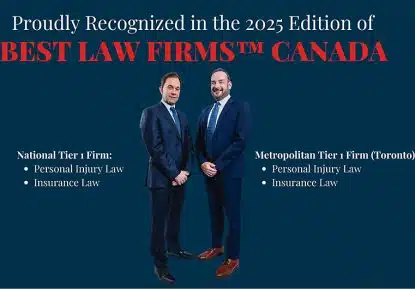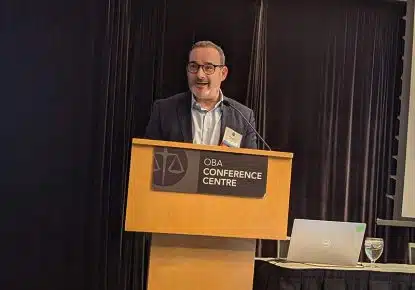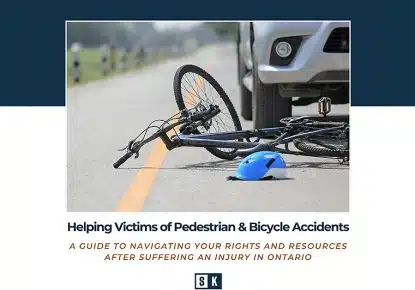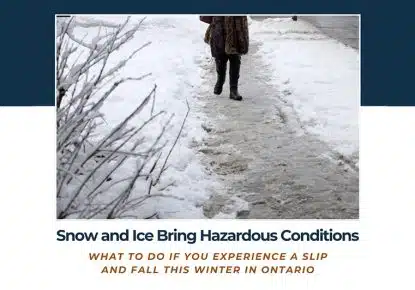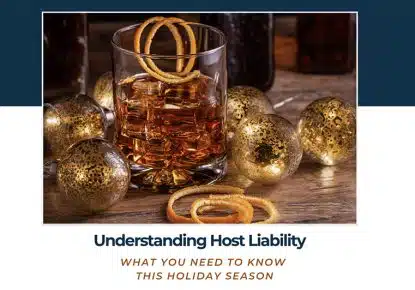
If you slip, who takes the fall?
From an icy sidewalk to a poorly lit walkway, it does not take much to cause a serious fall. This is one reason why slip and fall accidents rank among the most common property accidents, as well as the leading cause of injuries, in Canada.
While all property owners are responsible for maintaining the safety of their premises, determining liability in a slip and fall accident is not always a simple case.
What is premises liability law in Ontario?
In Ontario, fault in a slip and fall accident is determined by the Occupier’s Liability Act legislation. This legislation holds the occupier responsible for maintaining the safety of people who enter their property, and to keep them reasonably safe from danger.
The “Occupier” may be someone who owns the premises or the person in control of the activities, conditions or people allowed on the premises. This could include homeowners, who own the physical property, or a store manager, tenant or maintenance crew (e.g., snow removal crew) who are responsible for activities that take place on the property.
There can also be more than one occupier on a single premise, and therefore more than one party responsible for the accident. For example, partial fault may be assigned to a landlord and their tenant for an accident that occurs on a rented property, even if the tenant was the one injured in the accident. If the slip and fall victim is assigned partial responsibility for an accident, this may also impact the damages received.
For accidents on private property, victims must provide written notice to the occupier within 60 days of the incident.
How is negligence established?
To establish responsibility, or “liability”, for a slip and fall accident, it must be proven that the occupier is negligent in order for them to be entitled to compensation.
Typically, the injured party must prove one of the following:
-
The occupier should have recognized a dangerous situation (e.g., an uneven walking surface) and removed or repaired the potential danger, but failed to do so.
-
The occupier caused the dangerous situation leading to the slip-and-fall accident (e.g., leaving an obstacle on a walking path).
An insurance company may claim that a victim entered a dangerous situation that could have been avoided, such as if there were clear warning signs to prevent access to a potentially dangerous area. In this case, the victim may also be deemed negligent or at partial fault.
On the other hand, in order to hold the party responsible and therefore liable for damages, a victim must prove that the occupier failed to act as a reasonable person would have acted under the circumstances leading up to the accident.
This could include questions such as:
-
Did the occupier act reasonably to prevent or eliminate the hazardous condition or obstacle?
-
Did the occupier routinely check for potential hazards on the property? Is there a record of these procedures being followed prior to the accident?
-
Could the occupier have made the hazard less dangerous through preventative measures, such as placing warning signs or preventing access to the potentially dangerous location?
What about slips and falls on public property?
Municipalities, such as the City of Toronto, are also expected to ensure the safety of people who enter public properties, including parks, public buildings, roads or sidewalks. Therefore, a victim of a slip and fall case on public property can also file a claim against a municipality if the property is deemed unsafe.
In some cases, liability may be also assigned to a person or company hired by the municipality, such as a contractor hired to do maintenance or repairs.
It is important to note that for accidents on municipal properties, there is a shorter limitation period during which a victim can file a claim. They must provide the city with written notice of the claim within 10 days of the accident.
Are there any exceptions?
If a person enters a premises without permission, with the intent of committing an offence, it is assumed that they knew all risks, and therefore the occupier cannot be held liable for an accident which occurs.
In addition, the Occupier’s Liability Act does not apply to an employer and employees. In these cases, the injured party would be expected to pursue a workers’ compensation claim.
Next steps
After an injury in a slip and fall accident, it is important to file a claim within the limitation period and to consult with an experienced personal injury lawyer in order to receive the compensation you are entitled to for your injuries.
Remember, claimants must provide written notice to the occupier within 60 days if the accident took place on private property. If the accident took place on public property, they only have 10 days to provide the city with written notice of the accident.
For help with filing a claim in a slip and fall accident, contact our personal injury lawyers at Singer Katz for a free consultation.



